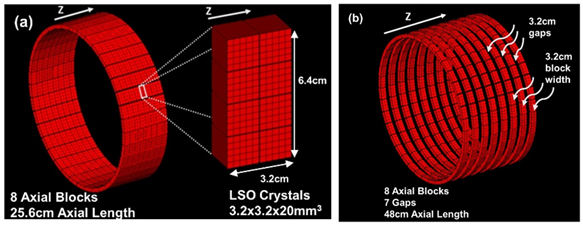Positron emission tomography (PET) sensitivity and applications (in particular those requiring simultaneous imaging of distant organs) are hindered due to the scanner limited axial field-of-view (AFOV), typically <26cm. A longer AFOV will create new opportunities to extend PET clinical and research applications to perform studies that benefit from simultaneous imaging of distant organs, such as simultaneous multi-organs kinetic modeling, and imaging of multi-system diseases.
Recent data from the world-first 2m long total-body PET, μEXPLORERTM (United Imaging, China), are breathtaking and confirm the great impact that a long AFOV will have on future PET applications. However, the dramatic increase in cost due to the large number of detectors required to cover the long axial FOV will remain a major limitation for the worldwide dissemination of such technology.
Sparse detector configuration offers a potential cost-effective solution to extending the axial scanner field-of-view. In recent work, using Monte Carlo simulations, the Nehmeh group showed the feasibility of carrying out PET imaging with only 50% of the detectors enclosed in a PET tomograph, and without impacting corresponding image quality.


